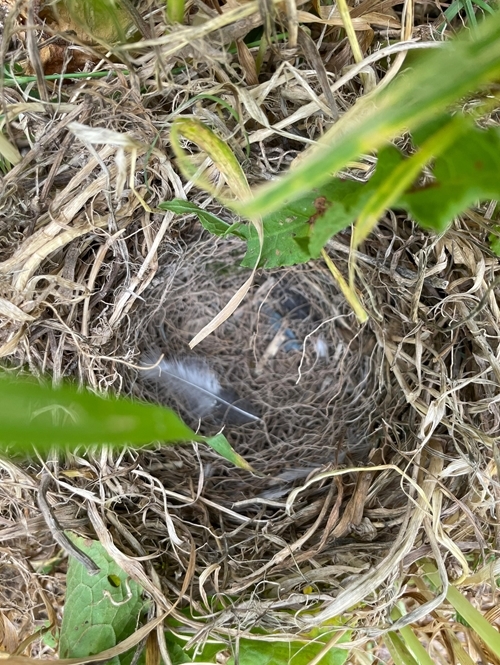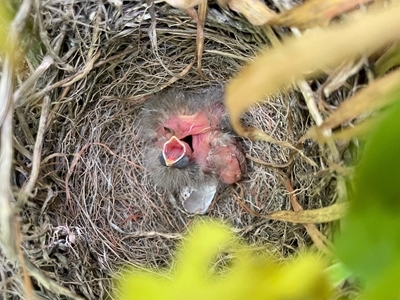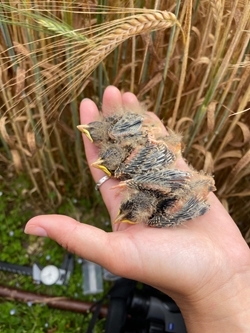By Ellie Ness, Farmland Ecology Research Assistant
 The jangle of a singing corn bunting is a sound that has disappeared from a lot of the country in recent decades. Sadly, these charismatic little birds are red-listed farmland specialists that have undergone an 83% decline between 1967-2022, so are in real need of help nationally. To some they might look like a boring ‘little brown job’, but in fact they are full of character, easy to fall in love with, and to me are one of the best sounds of summer.
The jangle of a singing corn bunting is a sound that has disappeared from a lot of the country in recent decades. Sadly, these charismatic little birds are red-listed farmland specialists that have undergone an 83% decline between 1967-2022, so are in real need of help nationally. To some they might look like a boring ‘little brown job’, but in fact they are full of character, easy to fall in love with, and to me are one of the best sounds of summer.
Corn bunting often fly around with their little legs dangling, one of the indicative characteristics of the species. The males leave all the hard work up to the female to build the nest, lay the eggs, incubate and rear the chicks - entirely by herself whilst the male chases her or just sits there singing to mark his territory. Though to give the males some credit, when the chicks have fledged the nest they do start to feed them, but up until that point the female has done all the hard work herself.
The project
We are lucky to still have good, stable populations of corn bunting on many of the farms we work with, local to the GWCT HQ. A lot of our local Farmer Clusters create habitats to help with breeding success and overwinter survival. One of these is the Cranborne Chase Farmer Cluster, where members of our Farmland Ecology team are monitoring their breeding success, to investigate their use of farmland habitats whilst foraging for invertebrate prey for their chicks.
Corn bunting are a ground-nesting species, often nesting in arable crop fields or grassland, if the grass is a suitable length for nesting. Our main focus is on birds using arable crops. Here corn bunting have a preference for cereals, often choosing barley to nest in, but they will use other crops such as peas, oilseed rape and beans. Our monitoring is focusing on cereals (wheat and barley), as these are where the highest densities of birds are. From a practical perspective, they are also the easiest crops to find nests in because they aren’t too high or thick. The nest itself is on the ground and is made up of dried grasses woven into a small cup.

How we survey corn buntings
The first step of fieldwork is selecting fields to try to find nests in. We pick fields with a few singing corn bunting males to hopefully indicate the presence of females. Corn bunting are a polygamous species, meaning they don’t form true pairs – one male can have multiple females and another male can have none. So for each male we have to figure out which males have females with them and what area of the field these females are preferentially using. This isn’t always easy when the males chase off any other corn bunting in sight. We pick fields ideally with a gentle slope where we can see a good proportion of the field from one spot.
The nest step is the most challenging and requires hours of work, and it can be frustrating at times watching empty fields or females seemingly doing nothing. Nesting stages can be quite spread out, with some females having chicks in the nest whilst others haven’t even started building yet. So figuring out the nesting stage of each female is the hard part. From her behaviour we figure out what she’s up to, and then have to try to find her nest. If we see her going back and forth fluttering with long bits of grass in her beak, then she is building her nest, but if we seeing her go in with big, juicy caterpillars then that shows she is feeding chicks. Finding a tiny cup of grass in a large, uniform arable field is not the easiest task, but with careful watching we usually manage to find the nest fairly quickly.
Assessing their diet
 If we find a nest at the building or egg stage, we return and check it once a week until it’s hatched. When it has hatched, we come back when the chicks are around 6 or 7 days old to ring them (all chicks are handled by licensed BTO ringers) and collect samples of their droppings. Our team includes a highly experienced entomologist who can identify what the adults have been feeding their chicks from invertebrate fragments found in the chick droppings. Whilst adult corn buntings primarily feed on seeds, they feed invertebrates to their young as these are full of protein which is needed for chick growth. Their most frequent food items are caterpillars but they also feed their chicks beetles, snails, flies, sawfly larvae, spiders and harvestmen.
If we find a nest at the building or egg stage, we return and check it once a week until it’s hatched. When it has hatched, we come back when the chicks are around 6 or 7 days old to ring them (all chicks are handled by licensed BTO ringers) and collect samples of their droppings. Our team includes a highly experienced entomologist who can identify what the adults have been feeding their chicks from invertebrate fragments found in the chick droppings. Whilst adult corn buntings primarily feed on seeds, they feed invertebrates to their young as these are full of protein which is needed for chick growth. Their most frequent food items are caterpillars but they also feed their chicks beetles, snails, flies, sawfly larvae, spiders and harvestmen.
To complement the analysis from the droppings, we take sweep net samples from habitats present within 150m of the nest. Any margins, plots and different crop types get sampled, with two samples taken per habitat type. These samples can then be used to relate the availability of the different invertebrate groups to what the corn buntings are actually feeding their chicks. This in turn provides insight into the value of each farmland habitat to the breeding corn buntings.
Fledging success
We do a final check on the nest just after chicks should have fledged to determine whether it was successful or not. The chicks usually fledge when they are around 12 days old, so it’s not long for them to go from a tiny naked chick to a fully feathered corn bunting! If we turn up and hear adults alarming at us and the nest is intact with a trail of droppings leading away from it, then we call the nest a success. Corn bunting chicks leave the nest before they can fly, with the chicks wandering off out into the crop, and the parents still bringing in food for a while after fledging until the chicks are completely independent themselves.


Left : Corn bunting nest with eggs. Right: Just hatched corn bunting chicks.
However, if we turn up and the adults are silent, the nest lining is pulled out or the nest damaged, sometimes with a few chick feathers scattered round the nest, then sadly we determine the nest has failed due to predation. This data allows us to calculate nest success rates across the different crops and farms.


Left: Corn bunting chicks around six days old. Right: A brood of chicks being handled for ringing.
All ringing is carried out under a BTO ringing licence.
All of this research requires a lot of work and it keeps our Farmland Ecology team busy! Travelling to multiple farms, assessing bird activity in each field, nest finding, tracking nest timings, ensuring no nest checks are missed and sweep-netting many different habitats across all nest locations all adds up to a demanding workload. It’s an intense few weeks from the start of June to late July when things start to quiet down due to most of the first broods having fledged. Though it’s full-on and tiring, it is my favourite time of year. Sometimes I can’t believe how lucky I am I get to do this for my job, out every day in the sunshine watching these amazing little birds.